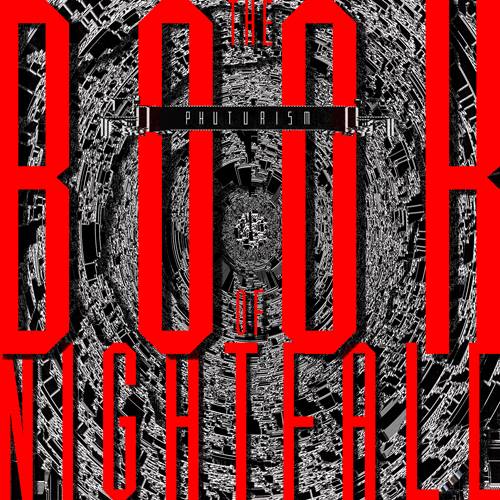 If you haven’t noticed, we’re somewhat obsessed with the mysterious OWSLA group that is Phuture Doom. Since their announcement of a new album last month, we’ve been on the edge of our collective seat anticipating what might be next. Then, we heard they had been added to the HARD Day of the Dead lineup and our excitement level went through the roof.
If you haven’t noticed, we’re somewhat obsessed with the mysterious OWSLA group that is Phuture Doom. Since their announcement of a new album last month, we’ve been on the edge of our collective seat anticipating what might be next. Then, we heard they had been added to the HARD Day of the Dead lineup and our excitement level went through the roof.
Now, the group has released one of the most insane things we have seen come out of the EDM scene probably ever: The Book of Nightfall. To our understanding, The Book of Nightfall is the first “scripture” of Phuturism, a new cult-driven religion that believes technology and humanity will somehow merge into one singular entity to reach a god-like status.
Phuture Doom has also released a new definition of what the name actually means:
Phuture Doom is a worldview merging occult ritual and transhumanism—an audiovisual infrastructure of clashing system functions—a revelation of human choices. The singularity nearing, cries to slow mechanization intensified but the waste patterns of modern consumerism persisted, nailing shut the coffin of our collapse. Forged from the limbs of the network, Black Acid poured from it’s sutures and prophesied the integration of man and machine, the advent of a new human kind.
The video/audiobook of The Book of Nightfall describes an eerie and not-so-far-off future in which humans are able to connect with each other by the means of “transhumanism” and singularity. The “book,” which is based on ACTUAL things happening in today’s society, isn’t really too far off with it’s predictions.
In all honesty, we’re still scratching our heads with this one, but take a look for yourself and see what you come up with:
We’ve even gone so far as to transcribe the actual Book of Nightfall for all the other die-hard Phuture Doom fans out there:
The Book of Nightfall is the first published scripture of Phuturism.
PHUTURISM: The Book of Nightfall
I. PROGRESS & INFORMATION̸
We can consider the history of humanity through its evolving relationship to time. The invention of the clock during the Renaissance gave birth to the industrial age and a culture of scheduling and productivity. A more profound transformation manifested as men switched from a culture of time to a culture of technology and computer programmed logic.
Relentless technological interaction created a human race addicted to calculation and quantification. A virtual and digital sixth continent emerged in parallel to the physical world, and the use of electronic tools allowed human access. The old world of values was disappearing with technology faster than thought. But the new world had, for the most part, arisen without a thoughtful architecture or blueprint.̀
II. ECONOMY͘
The hegemony of calculation developed daily life and the intangible began to supplant the real. Comparing the human brain to an extraordinary computer objectified the individual, forcing a reorganization of perception. The value of an individual’s brain is developed in the economy, and to the extent that an individual is his brain, he fought to avoid its disturbances and utilize tricks to improve its functioning. Competitive advantages raised the standard of competition as each person became his own company.
The objective was to improve the competitive performance of world economies by increasing the performance of individuals. Expansion and Performance are two key concepts for understanding how links have been built between trans-humanist thought and neoliberal logic. The adaptability of individuals in all circumstances was the rule which increased competitive advantage against those who abstained.
A functional society was born, turning the individual into a technical fragment, a detached part of the species. Science was no longer only a means of innovation, but the way of life and existence. By agreeing to be an animal like the others, man ended up being treated like an animal himself.
III. BIRTH OF AN IDEOLOGY: TRANSHUMANISM
A classical understanding of perfectibility, dating from the eighteenth century, is the idea that man can improve and perfect himself by education and other forms of self betterment; but this idea was abandoned and criticized. What prevailed was the notion of indefinite improvement aimed at ultimate positive transformation of the the human condition.
Transhumanism was born out of this desire to forge a perfect man. The followers of this new philosophical and scientific movement wanted to use all means of technology to enhance the capabilities of the human. There were many transhumanists worldwide, but North American and especially Silicon Valley futurologists had incommensurate influence on transhumanist thought from the beginning with an ideologically libertarian approach.
IV. BIO TECHNOLOGY
At the time the biggest problem was not imagining the future of technology, but convincing people of what already existed. Military research had already changed their lives with the birth of the Internet, and its agencies shifted focused to biological programs and human improvement. In only a few decades time, the exponential growth of technology produced extreme interfaces between the human body and machine.
At first, most tests were conducted on the disabled to garner attention and unlock budgets, but its applications quickly multiplied. Non-surgical self-augmentation created a mass market for all kinds of accessories, positioning the human body at the latest peak level of consumerism. The disabled became more efficient than the valids and quickly began surpassing them.
What was once called the computer, cellphone, or tablet was already a form of improvement for transhumanists because these digital prosthesis had become external organs and a part of human identity. Prosthesis was initially for medical reasons, mechanization of method of survival.
But the speed of technological change became so fast that partial fusion was necessary for the brain. it could retain it’s original biological state and face the wave of information that would soon overwhelm. Machines crept into the body, merging with the organs and senses, giving birth to a new human race: the post human transcendent man.
V. IMMORTALITY
Technological evolution of man’s biologically fallible body allowed humanity to consider death as never before. Advancements in brain imaging research dangled indefinite longevity by safeguarding awareness on digital media. In other words, a promise of immortality. For mankind, death was always considered tragedy, but for a long time knowledge was not required to live indefinitely.
Exceeding humanity meant integrating into the network, no longer limiting the human body soely to hand-typed communication using the internet, but becoming part of the network itself by integrating with the Machine world. A world only acceptable on account of promised immortality.
VI. RELIGION
Science and technology led to the transcendence of human limitation and power to overcome suffering, illness, depression and other adverse conditions. It became a religious substitute men could not possibly ignore masked in a cloak of rationalism. However, if science is emancipatory, scientism is enslaving. Those in control of large dense information networks weren’t as interested in world rule as technologically fueled life improvement. but access to increasingly sophisticated and expensive technology eventually stopped serving the common good and became elitist sport.
A violent class division thus formed, on the crux of a fierce political debate. There was no need to exterminate people, they will disappear by themselves because they are smaller and therefore doomed to disappear. This is the accepted fracture, the hyphenation, and this is what led to the Great Schism.
…say what!?
For more on Phuture Doom, check out their Facebook, SoundCloud, Twitter, and the Official Phuturism Website.
Phuture Doom is pretty nuts. Tell us what you think about Phuturism: The Book of Nightfall on our Facebook page.

Comments are closed.